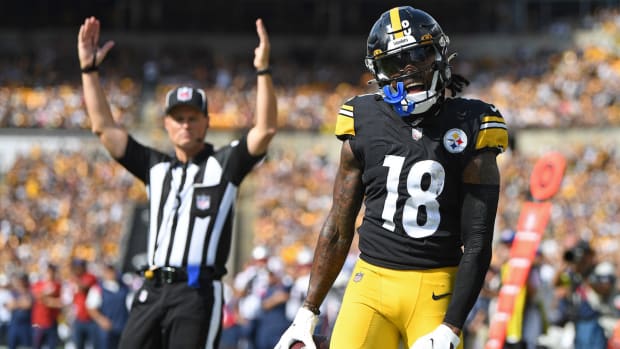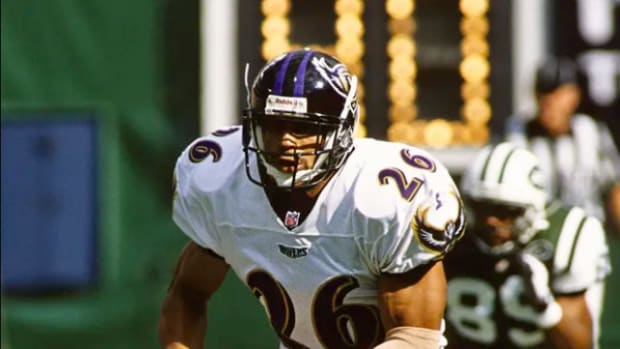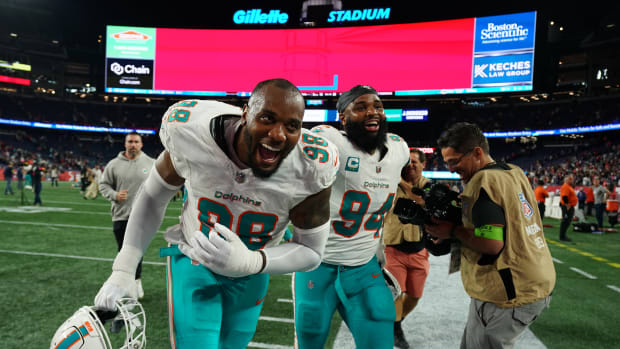Fantasy Football: Aaron Jones, Chris Godwin Among Early 2019 Breakout Candidates
June has arrived and with it another year of fantasy football draft prep. We’ll have you covered all summer as you get ready for your drafts and auctions, running forward and backward across the entire fantasy football landscape. To start, we’re setting the scene with sleepers, busts, breakouts and bouncebacks (coming soon).
Before we can identify breakout candidates, we have to agree on exactly what type of player we’re looking for. While a breakout can certainly come from out of nowhere—hello, 2018 James Conner—that brand of player isn’t necessarily what we’re looking for in June. Standard breakout candidates are already well known to the fantasy community at large, often with an established track record of success. What makes them breakout candidates is the plausible chance that they will reach new heights this season, and then be good bets to remain there for the foreseeable future. For example, Juju Smith-Schuster and Robert Woods are two breakout candidates who came through on their promise in 2018. Breakout candidates aren’t being drafted in the 10th or 12th or 15th round. They’re being taken in the middle, somewhere in the range between the fourth and eighth rounds, and turning themselves into players who will be selected in the top-three rounds in 2020.
ADP data is courtesy of Fantasy Football Calculator.
Aaron Jones, RB, Packers (ADP: 32.6)
Prepare yourself for a lot of Jones propaganda on this website over the next 10 weeks or so. Jones is my favorite target with an ADP outside the top 30, coming off the board at an average pick of 32.6, which places him late in the third round of 12-team leagues. Jones is, without question, the best back in Green Bay. That much was obvious after 2017, when he piled up 448 yards and four touchdowns on just 81 carries. Jamaal Williams, who led the Packers in carries that season, turned 153 rushes into just 556 yards and the same four touchdowns.
The only reason Jones is even eligible to be a breakout candidate this year is because of Mike McCarthy’s coaching malpractice. Despite the evidence of the previous season, McCarthy remained committed to splitting work between Jones and Williams. Jones was electric yet again, turning 133 carries into 728 yards and eight touchdowns, and catching 26 passes for 206 yards and another score. Williams, meanwhile, plodded his way to 464 yards and three touchdowns on 121 carries. The two are at the top of Green Bay’s depth chart for the third straight season, but this should finally be the year that the team embraces Jones as its workhorse.
Assuming new head coach Matt LaFleur goes in that direction, Jones is in line for a monster year. Previous results do not guarantee future performance, but Jones’s career to date provides a nice jumping off point, considering his workload over his the first two years of his career translates well to a full season as a workhorse on a per-start basis. He has played in 24 games, but started just 12, totaling 1,176 rushing yards and 12 touchdowns on 214 carries, and 228 receiving yards and one score on 35 receptions and 53 targets.
Chris Godwin, WR, Buccaneers (ADP: 49.5)
Godwin is already getting plenty of love this summer. It’s easy to be excited about Godwin considering everything that has happened with respect to him since last September. Consider the following.
• Godwin caught 59 of 95 targets for 842 yards and seven touchdowns at 22 years old in his second NFL season. He ended the season ranked 25th among receivers in fantasy scoring in half-PPR leagues. Of the players ranked ahead of him, only Tyler Lockett, Calvin Ridley and Mike Williams had fewer targets.
• He ranked third on the team in targets behind Mike Evans (138) and Adam Humphries (105). On a per-game basis, he was also behind DeSean Jackson (6.2 to 5.9). Godwin got 28 targets in the four games Jackson didn’t play, catching 12 of them for 238 yards and three touchdowns.
• The Buccaneers hired Bruce Arians, who’s as offensive-minded and pass-happy as they come, as their head coach.
• The team traded DeSean Jackson to the Eagles.
• Adam Humphries signed with the Titans.
Godwin spent all of last year scrounging for targets, turning a 15.2% target share into top-25 numbers at the receiver position. He enters this year as the unquestioned No. 2 receiver on the team, with 179 targets vacated by Jackson and Humphries. The most significant pass-catcher the team added in the offseason, meanwhile, was Breshad Perriman. Add it all up, and you get an easily navigable path to about 120 targets for Godwin. And with those targets coming in an Arians offense, Godwin could be a monster this year. I’ll be shocked if he isn’t a top-20 receiver, and I’m willing to bet on him finishing inside the top 15.
Hunter Henry, TE, Chargers (ADP: 66.8)
Henry almost has a post-hype feeling to him considering that his eight-touchdown rookie season was now three years ago. Since then, he took a backseat to a suddenly unretired Antonio Gates in 2017, and missed all of 2018 after tearing his ACL in OTAs. Three years after he appeared on the precipice of becoming one of the premier tight ends in the league, Henry is ready for his breakout.
Gates is gone for good, with the first tight end on the depth chart behind Henry being Virgil Green. He’s not going to have any serious competition for looks at his own position. Keenan Allen soaks up plenty of targets, but he’s the only receiver on the team who commands a large target share. Mike Williams, dangerous as he is, had 66 targets last season. That number will likely increase next year, but he’s not likely to suddenly turn into a 100-target receiver. Melvin Gordon has proved his receiving chops over the last few years, but he, too, isn’t likely to limit Henry’s target upside. The fourth-year tight end isn’t going to be lacking opportunity.
We’ve seen far less of Henry than we would’ve liked over the first three years of his career, but it’s hard to find fault with anything we have seen. He’s had 115 targets in his career, catching 81 of them for 1,057 yards and 12 touchdowns. For sake of comparison, the big three at the position—Travis Kelce, George Kittle and Zach Ertz—had 150, 135 and 156 targets last year. Eric Ebron had 110, while Jared Cook had 101. It’s totally reasonable to think Henry could hit 115 targets in a single season, even with a high-volume back like Gordon on the roster. Give a player like him that many looks in an offense like this, and the payoff could be massive.
The Chargers were right on league average in passing rate in neutral game script (game within one score) and negative game script (trailing by more than one score), but 10th in positive game script (leading by more than one score). The Chargers are expected to be Super Bowl contenders, but considering the team’s tendencies last year, there’s no reason to expect playing with a lead will reduce its willingness to put the ball in the air.
Robby Anderson, WR, Jets (ADP: 73.1)
Anderson has spent his first three years with the Jets fighting an uphill battle. Todd Bowles, a head coach who came up on defense, never seemed to have things together on offense. Ryan Fitzpatrick was the team’s primary starting quarterback in Anderson’s rookie year, followed by Josh McCown in 2017. Sam Darnold showed plenty of promise last year, but he was still a rookie playing on a bad team with an overmatched coaching staff. Those are nearly impossible odds for a receiver. Yet, Anderson made something at least approaching the most of it, catching 155 passes for 2,280 yards and 15 touchdowns over his first three seasons. He was even better the last two years, putting up seasonal averages of 57 catches, 847 yards and 6.5 touchdowns.
There’s good reason to believe that everything Anderson has been building could come to a crescendo this year. First, while Darnold didn’t have a rookie year quite like Baker Mayfield’s, he did show enough to think he can be a legitimate franchise quarterback. He and Anderson were in sync at the end of the season, with the duo hooking up for 23 receptions, 336 yards and three touchdowns over the final four games of the year. Anderson is far and away the team’s top pass-catcher, in terms of both talent and reputation, and could turn into a target hog this year.
The Jets fired Todd Bowles and replaced him with Adam Gase, who has spent his entire professional career on the offensive side of the ball. Say what you will about Gase, and there’s plenty to say about his post-Denver career, there’s no doubt that he brings more to the table from a fantasy perspective than Bowles. He may prove to be no better for Anderson than Bowles was, but he certainly can’t be worse.
Anderson is now in his fourth year in the league and is 26 years old. Developmentally, this is a career spot and age in which we’ve seen a lot of receivers make the leap. Environmentally, things have never been better for him. Anderson is one of this season’s prime breakout candidates.
Dante Pettis, WR, 49ers (ADP: 84.8)
One of the best ways to find a breakout candidate is to look on an offense that has reason for optimism as a whole in the upcoming season. The 49ers certainly fit that bill, with a healthy Jimmy Garoppolo teaming up with Kyle Shanahan, who did incredible work considering all the injuries the team suffered last year. Despite losing Jerick McKinnon before the season and Garoppolo in September, and having a receiving corps led by Marquise Goodwin, Pierre Garcon and Kendrick Bourne, the 49ers finished the year 16th in total offense and 13th in yards per play, just behind the Packers and Browns. Give this team a healthy Garoppolo and McKinnon, put Tevin Coleman in the mix, and add another year of seasoning to Shanahan’s head-coaching chops, and you get a recipe for a potential breakout offense.
Should this team reach those new heights, at least one receiver is going along for the ride. George Kittle is one of the best tight ends in the league, but he can’t do all the heavy lifting in the passing game. The team whiffed on its pursuits of Odell Beckham and Antonio Brown, leaving last year’s group of receivers mostly intact. Of that group, Pettis is easily the most promising. A second-round pick in the 2018 draft, Pettis played only sparingly the first half of the season. Going into the team’s 10th game, he had just eight targets. Over its next six, he got 37 looks, pulling down 24 of them for 371 yards and four touchdowns. That comes out to a 16-game pace of 64 catches for 989 yards and 11 scores. And remember, he did all of that with Nick Mullens at the helm. No offense to Mullens, who did a great job with the hand he was dealt, but clearly Garoppolo has more upside and can take the offense to a new level. Pettis’s status as the team’s top receiver gives him a top-15 ceiling at a wildly affordable price.




































